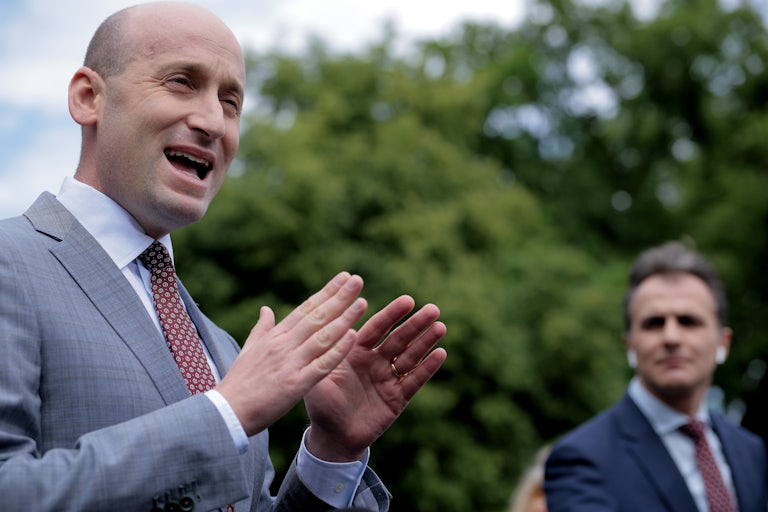How Can the Democrats Be Losing to These Cruel, Stupid, Inept People?
You may have noticed: While Republicans debate Medicaid and other cuts, there’s one aspect of Trump’s big ugly bill that absolutely cannot be discussed.

Senate Republicans have no “big, beautiful” bill. It isn’t close to finalized. The Senate parliamentarian, combing through the details and determining which provisions will need a supermajority to pass, is hammering them. They’re locked in ferocious internal debate about the cuts to Medicaid. They haven’t held a single hearing on the bill in any committee.
And they say they’re going to start voting on it tomorrow.
Even worse is the complete hypocrisy of the thing, which has been true of every Republican tax bill going back to 1981. Ever since Arthur Laffer sold the GOP on his ridiculous curve, they’ve been lying to the American people about how their tax cuts will produce more revenue. It has never happened. Ever. Some of the dumber Republicans may believe this, but the smarter ones know Laffer’s theory is a lie, and they say it anyway.
And so we watch as Senate Republicans argue about the degree to which they want to destroy Medicaid. You’ve been reading and hearing about this, I’m sure, and you may even have become familiar with the phrase “provider tax.” Journalistic shorthand usually does a poor job of explaining what that actually is. Bear with me for this brief explanation, because it makes clear how cruel and deliberate these cuts are.
Health care services that are reimbursed by Medicaid are, well, provided by a range of different “providers.” Chief among these are hospitals, but the category also includes nursing homes, other long-term care facilities, doctors, physical therapists, even chiropractors: all sorts of people. But the big money revolves around hospitals, and specifically rural hospitals, which rely heavily on Medicaid dollars because they are poorer on balance than other hospitals. They tend to be run on a nonprofit basis. They are less likely than urban or suburban hospitals to have commercial insurance, and they’re more dependent on Medicaid revenue because their client base tends to be poorer. There are about 1,800 rural hospitals in the United States. Here’s a map.
OK. Starting in the 1980s, during an earlier funding crisis, Congress allowed states to start taxing providers. In many states (this gets very complicated, and I’m not going to go into it that deeply), the cap on the tax that states can charge hospitals is 6 percent of the patient revenue money (it’s called the “safe harbor maximum” in wonkspeak). The Senate bill seeks to lower this cap over a few years to 3.5 percent.
To make a long story short, when you reduce a tax, you reduce the amount of revenue it brings in. It’s also worth bearing in mind here that Medicaid reimbursements rarely cover the cost of care to begin with, so these cuts will make an already dire situation much worse. Governors and state legislatures will be staring at a quite substantial reduction in Medicaid tax revenue. They will then be faced with three choices: one, raise some other sort of tax; two, cut some other state service, like education; three, cut Medicaid services.
As congressional Republicans well know, most states are going to choose number three, because it’s the easiest path. And that brings devastation. If you want to see why Republican Senator Thom Tillis is so freaked out, click on that map above and zoom in on his state, North Carolina. You’ll see in detail how many rural hospitals there are operating at a loss, and how many have already closed.
So this is what Republicans are debating—and deliberately and dishonestly telling the American people that it’s a simple case of cutting “waste, fraud, and abuse,” as if they have no choice in the matter.
It’s a monstrous lie.
They have a choice. But of course it’s a choice they’ll never make. What is that choice? They could, in theory, reduce the tax cuts to the rich. The problem would be instantly solved.
The proposed Medicaid cuts come to around $800 billion. The cost of making the 2017 income tax cuts permanent is around $2.2 trillion. So in other words, canceling the tax cuts would more than cover the proposed Medicaid cuts. In fact, the Republicans could leave nearly two-thirds of the tax cuts intact, and just pare them back, and leave Medicaid untouched.
In a fantasy world, they could, dare I say it, eliminate the tax cuts altogether. They’d have $2.2 trillion to play with, and they could expand rural health care—you know, actually do something of substance for all the people who vote for them, besides scaring them into thinking that Democrats want to steal their guns and neuter their children.
But you notice: No one ever, ever, ever discusses the tax cuts. No one. None of the, ahem, moderates—not Senator Susan Collins, not Representative Mike Lawler (at least that I’ve heard). Tax cuts aren’t written in ink and on paper, to Republicans. They’re written in lightning on tablets from Mount Sinai. They cannot be discussed.
And these aren’t just your usual, run-of-the-mill GOP tax cuts. They’re worse. They’re the most redistributive tax cuts in modern American history, and by redistributive, I don’t mean from the top down. I mean to the top from the rest of us.
Here are a few facts about the House’s version of the bill, from the Institute on Taxation and Economic Policy, or ITEP:
- The richest 1 percent of Americans would receive a total of $121 billion in net tax cuts in 2026. The middle 20 percent of taxpayers on the income scale, a group that is 20 times the size of the richest 1 percent, would receive less than half that much: $56 billion in tax cuts that year.
- The $121 billion in net tax cuts going to the richest 1 percent next year would exceed the amount going to the entire bottom 60 percent of taxpayers (about $79 billion).
- The poorest fifth of Americans would receive less than 1 percent of the bill’s net tax cuts in 2026, while the richest fifth of Americans would receive 70 percent. The richest 5 percent alone would receive 45 percent of the net tax cuts that year.
There’s a lot more. The richest 1 percent ($916,900 and above) will get an average cut of $68,430, or 2.5 percent. The poorest 20 percent (up to $27,000) will get a whopping cut of $30, or 0.2 percent. In percentage terms, the cut for the rich is 10 times the cut for the poor.
But wait—incredibly, it gets worse. ITEP estimates that when you throw in the costs of Donald Trump’s tariff proposals, the net impact on the bottom 20 percent will be a tax increase of 2.2 percent. The tariffs aren’t finalized, of course, so we can’t really know the hard number, but as a general rule, tariffs cost poorer people more since they’re spending a far higher percentage of their income on imported necessities.
The whole thing is just a disgrace. A policy disgrace. A moral disgrace. Rural hospitals will close, and working-class people will die so that Trump’s golf buddies can get tax cuts of tens or hundreds of thousands of dollars.
The American people don’t know all the above facts and figures, but they do seem to know in their bones that this bill is a heist. It’s deeply unpopular. But even so, the Democrats could be doing much more here. Why don’t they fan out across the country one day next month and have events at money-losing rural hospitals that face potential closure? Back in the spring, when they did those anti-DOGE events in Republican districts, it seemed to have an impact. At least they were visibly doing something. There are rural hospitals in every state. Democrats could do a lot worse than to try to show rural Americans that they care.
But it’s like Jon Lovitz, playing Michael Dukakis, said on Saturday Night Live back in 1988: I can’t believe we’re losing to these guys. If Democrats were more aggressive, this bill would kill Republicans off in 2026 and 2028. It’s that cruel, it’s that stupid, it’s that inept. Democrats need to find dramatic ways of saying so.








